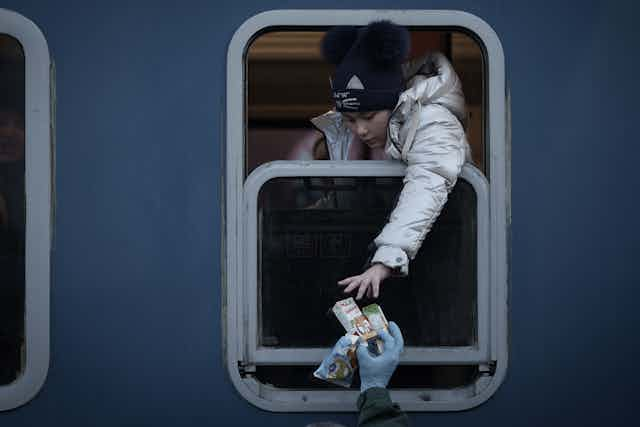An estimated three million people have fled Ukraine in the last three weeks, triggering an extraordinary response from governments around the world, including New Zealand. But the question begs to be asked – why have Ukrainians been welcomed when others fleeing violence have not?
The New Zealand government’s announcement to grant temporary protection to 4,000 Ukrainians who are family members of people already living here is welcome. It will provide a sense of relief knowing that there is a short-term solution to provide safety and security in a situation that has quickly spiralled out of control.
Of course, Ukrainians need to get somewhere safe, and we know there needs to be an international response to ensure neighbouring countries keep their borders open. Let’s face it, they’re not countries that usually welcome refugees and asylum seekers.
A Eurocentric approach
But there’s something very Eurocentric in this response, starting within the borders of Ukraine itself. In the early stages of the Russian invasion there were numerous reports of people from African, Asian, Middle Eastern and Caribbean nations being refused passage through the checkpoints leading up to the border to Poland and then being refused admission when they finally reached the crossings.

We can see similar dynamics playing out across Europe and other Western nations. The outpouring of support and even opening of people’s homes is being witnessed at a scope and scale not seen during the height of the so called ‘European refugee crisis’ in 2015 as hundreds of thousands of equally desperate people made their way across land borders and the Mediterranean to escape persecution following the Syrian civil war.
There were notable exceptions at the time, but the Ukrainian situation has very different political overtones and public receptivity.
This concerning trend is not just about protecting those “like us” but also about keeping the “other” out. Thus, the label of Eurocentrism is not strong enough. This trend highlights how racism often operates in implicit and, at times, explicit ways.
A quick response is possible
The New Zealand government’s announcement regarding the Ukrainians fleeing their homes shows that we can act relatively quickly to humanitarian crises. However, the current response is disproportionate to recent conflicts in other parts of the world.
Read more: As the Taliban's grip on Afghanistan tightens, New Zealand must commit to taking more refugees
According to the 2018 Census, 1,281 Ukrainians are living in New Zealand. There are also 1,635 Ethiopians residing here. Why wasn’t such a scheme developed when the conflict in Tigray escalated into war in late 2020? An estimated half a million people have died in the region from protracted conflict, famine and lack of health care, and two million have been forcibly displaced.
As the Taliban stormed into Kabul with breathtaking speed, I watched Afghan friends and colleagues despair as they saw very limited options to support those who were directly targeted.

The New Zealand Government did finally respond by introducing Critical Purpose Visa. According to the Immigration New Zealand website, 1,168 Afghans have arrived under several visa schemes since August 2021.
However, these visas were designated for those who worked for or supported New Zealand government initiatives, military, and human rights defenders, especially women. They were not primarily intended for family reunification.
The Rohingya people from Myanmar continue to struggle to support their families in the world’s largest refugee camp in Bangladesh, with little prospect of being able to safely return home. Approximately 745,000 people (an estimated 400,000 of them children) remain stuck in Cox’s Bazar following state sanctioned violence and persecution in 2017.
Similar stories can be told of South Sudan, Yemen, Iraq – the list continues, asking tough questions of who is deserving of protection and who is less so.
Meeting our commitments
So, what more can be done in the New Zealand situation?
The New Zealand government doubled its annual historic refugee quota of up to 750 people to 1500 in 2020. Due to the Covid pandemic, however, these numbers have never been realised, with the 2020-2021 intake only accommodating 260 people.
The current intake year is expected to take fewer than 1,000. Similarly, planned and budgeted increases to family reunification have fallen well short.
Last year, just one person was reunited through this visa category and only 54 people of the 600 allocated spaces have arrived this year. At the very least, New Zealand could commit to taking these places retrospectively, ensuring we meet obligations we have already signed up to.

There are other areas where we could bolster our commitment to the universal rights to refugee protection, regardless of race, religion or other factors leading to persecution.
For example, asylum seekers whose claims for refugee status have already been approved face delays of several years before their permanent residence is granted, meaning they cannot apply for reunification of family members who often remain in precarious situations.
Our recent report, entitled Safe Start, Fair Future highlights how these delays have more than tripled over the last decade. In 2011, 90% of applications were completed in 309 days; it now takes nearly 1,000. Fast-tracking these applications would make a real and tangible difference to people creating a new life in New Zealand.
While the specific policy details are still coming to light, New Zealand has an important role to play in protecting Ukrainians and other populations forcibly displaced in humanitarian crises. The Ukrainian response is welcome. Now let’s lift this standard to other groups equally deserving of support and protection.

